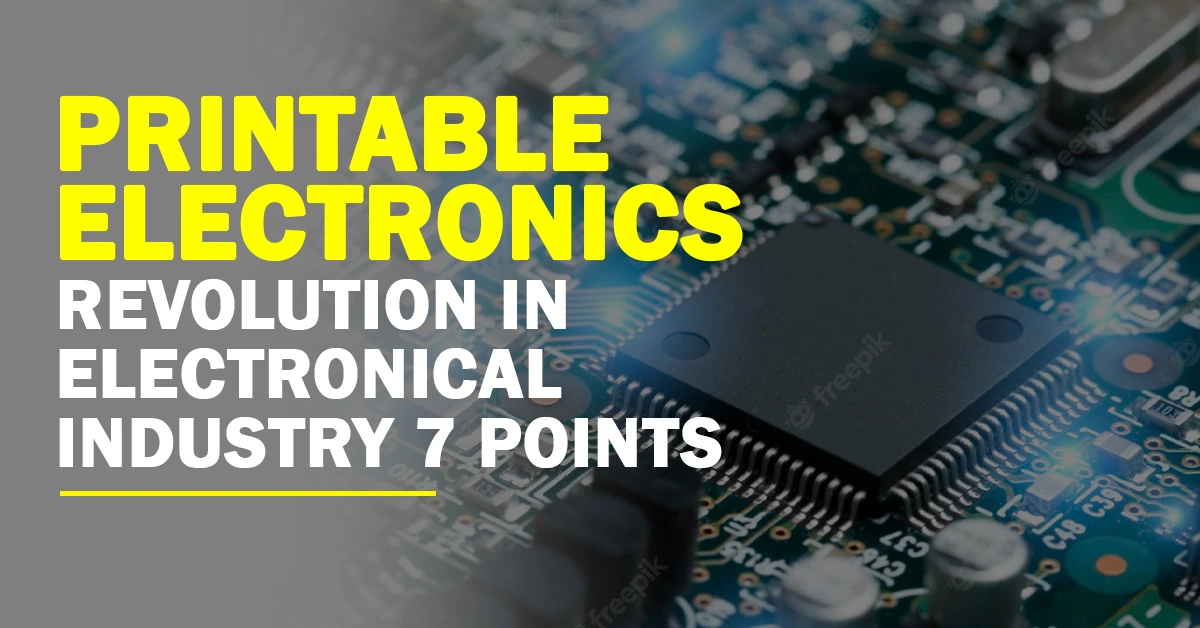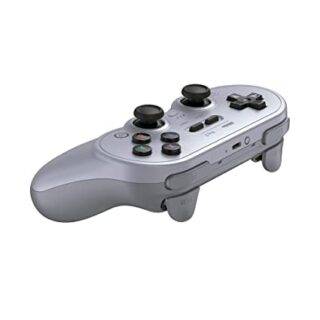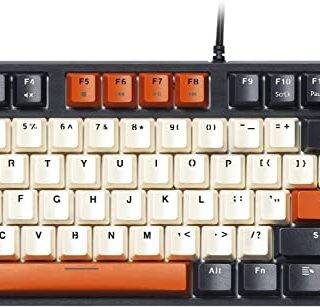
Table of Contents
ToggleIntroduction to Printable Electronics

A rapidly expanding area that combines the disciplines of electronic engineering and printing technology is printable electronics, commonly referred to as printed electronics or flexible electronics.
Through the use of conductive inks on a variety of substrates, including plastic, paper, and textiles, electrical devices and components are created using this novel method. The ability to produce affordable, lightweight, flexible devices with a variety of applications will likely transform the electronics industry.
The idea of printable electronics has its origins in the middle of the 20th century, but it really came to light in the first decade of the 21st because new developments in materials science, nanotechnology, and printing methods made it possible to create printed electrical components that were more effective and dependable.
Sensors, batteries, displays, solar cells, and other gadgets and parts are just a few examples of printable electronics. These parts are simple to incorporate into consumer goods, wearable technology, and industrial uses, opening up new possibilities for growth and innovation across a number of industries.
The affordability of printed electronics is one of their main benefits. Traditional methods of making electronics, such photolithography, demand pricey, complicated equipment, cleanrooms, and lengthy processing periods.
Contrarily, printable electronics can be created using standard printing techniques, which can considerably lower production costs and allow for quick device development.
Additionally, printable electronics are frequently thin and flexible, which can be helpful for a variety of applications, including e-textiles, portable electronics, and wearable technology.
Continuous improvements in printing techniques and materials have spurred the expansion of the printable electronics market. Silver, carbon, and graphene are just a few of the materials that have been incorporated into conductive inks, which are necessary for making printed electrical circuits.
The performance of printed electrical devices depends on the particular qualities that these materials have, like high conductivity, flexibility, and environmental stability. A variety of substrates can now be printed with accuracy and high-resolution using printing processes as inkjet printing, screen printing, and flexographic printing.
As long as continuing research and development efforts keep expanding the capabilities of this technology, printed electronics have a bright future. The manufacturing of traditional electronics is likely to be disrupted as printed electronics become more effective, dependable, and reasonably priced.
This will open up new prospects for innovation in a variety of sectors. The future of technology will be greatly influenced by printable electronics, which have the potential to revolutionize industries like consumer electronics, healthcare, energy, and transportation.
If you want to know more about Printing technology, read our article on The Future of Printing Tecnology.
Materials used in Printable Electronics

The ability to print electronic components and devices requires a wide range of materials. These materials need to have specific properties, like conductivity, flexibility, and compatibility with various printing processes, in order to meet the requirements of multiple applications.
In this context, the material choice affects the functionality, dependability, and cost viability of printable electrical equipment.
Conductive ink, which is one of the essential components of printable electronics and is used to create printed electrical circuits, is a fundamental component.
The components of conductive inks are conducting particles suspended in a liquid medium, such as metals, carbon-based compounds, or conductive polymers. Elements including conductivity, flexibility, and price influence the choice of conductive particles for the ink.
For instance, because of the high price of silver, silver-based inks can be costly despite having high conductivity and outstanding performance. Graphene- and carbon nanotube-based inks, on the other hand, they provide a more affordable alternative with good conductivity and flexibility.
Organic semiconductors, such as organic field-effect transistors (OFETs) and organic photovoltaics (OPVs), have drawn a lot of attention because of their potential for low-cost and large-area manufacture.
In printable electronics, substrates are essential because they serve as the base on which electronic components are printed. The performance, flexibility, and durability of the printed electrical device can all be considerably impacted by the substrate choice.
Paper, textiles, and plastics like polyimide and polyethylene terephthalate (PET) are typical substrates for printable electronics. These substrates are useful for a variety of applications due to their numerous benefits, including flexibility, light weight, and compatibility with various printing processes.
Printing Techniques and Technologies

The development and manufacture of printable electronics depend heavily on printing methods and technology. The performance, scalability, and cost-effectiveness of printed electronic devices can all be strongly impacted by the printing technology selected.
To fulfill the unique needs of printable electronics, such as high-resolution, precision, and compatibility with various materials and substrates, many printing techniques have been modified and improved. Inkjet, screen, gravure, and flexographic printing are some of the most frequently used printing methods in printable electronics.
- Inkjet printing: Inkjet Printing is a well-liked technique for producing printed electronics because of its high resolution, precise material deposition, and compatibility with a variety of substrates. Small conductive ink droplets are ejected from a printhead onto the substrate in this non-contact printing method to create electronic parts and circuits. Because it enables quick design changes and little material waste, inkjet printing is especially well suited for prototyping and low-volume production. The method can be a bit slow, therefore it might not be the best choice for high-volume production.
- Screen printing: Screen Printing is a well-known printing technique that includes applying conductive ink to the substrate using a stencil or mesh screen. This process has a high throughput, which makes it appropriate for the mass manufacture of printed electronics. Screen printing is capable of producing relatively sharp images and is versatile enough to work with conductive, dielectric, and semiconducting inks, among other materials. In contrast to inkjet printing, it can be less accurate and may call for many passes to obtain the appropriate layer thickness.
- Gravure Printing: Using an etched cylinder to deposit conductive ink onto the substrate, gravure printing is a roll-to-roll printing technology. This technique is used in the printing and packaging industries and is noted for its high-speed printing capabilities. Gravure printing has benefits for printed electronics, including high productivity, uniform ink deposition, and compatibility with a range of substrates and materials. The process, however, can be restricted for small-scale or specialized applications because to the expensive initial equipment and engraved cylinder production costs.
- Flexographic Printing: Another roll-to-roll printing method, flexographic printing employs flexible relief plates to apply conductive ink to the substrate. As a result of its adaptability, rapid manufacturing, and compatibility with a wide variety of materials and substrates, this technique is frequently utilized in the printing business. Flexographic printing can be advantageous for printable electronics due to its high throughput, constant layer thickness, and minimal material waste. To get the appropriate resolution, it could need more passes and be less accurate than inkjet printing.
For printable electronics, considerations including resolution, throughput, cost, and material compatibility influence the printing technology selection. The best printing technique will rely on the particular specifications of the printed electronic device or component being manufactured.
Each printing technique has benefits and drawbacks. Advances in printing technologies will surely be vital in enabling new applications and propelling the expansion of this interesting business as the field of printable electronics continues to develop.
Flexible and Stretchable Electronics

A subtype of printable electronics known as flexible and stretchy electronics has special mechanical qualities that enable them to bend, twist, and stretch without losing functionality.
In applications where conventional rigid electronics are inappropriate or unfeasible, these features have created new opportunities for electronic devices and systems.
Innovations in materials science, printing methods, and device design have fueled the development of flexible and elastic electronics, enabling the development of novel devices with extraordinary form factors and adaptability.
Typically, flexible electronics are created by printing electrical components onto thin, flexible substrates like fabrics or plastics. These substrates not only offer mechanical flexibility but also aid in making flexible electronic devices small and light.
Numerous benefits come from this flexibility, including the capacity to adapt to irregular surfaces, improved resistance to mechanical stress, and increased mobility. Flexible screens, wearable electronics, e-textiles, and flexible solar cells are a few typical applications of flexible electronics.
Contrarily, stretchable electronics go beyond flexibility by utilizing components and materials that permit the electronic parts to enlarge without losing their functioning. stretchy electronics are frequently made possible by utilizing cutting-edge components that allow the electronic parts to flex without breaking, such as stretchy conductive inks or elastomeric substrates.
Stretchable interconnects, for instance, can be created to retain electrical continuity even when mechanical deformation is present. Conductive traces, for instance, can be engineered to accommodate stretching using serpentine or wavy patterns.
Flexible and stretchable electronics have many uses because of their special qualities, especially in fields where standard electronics have limitations. One such field is wearable technology, where flexible and stretchable electronics can be incorporated into clothing, accessories, and even directly onto the skin to produce discrete and comfortable gadgets for health monitoring, fitness tracking, and other uses.
Flexible and stretchable electronics can be utilized in the medical industry to create implanted gadgets, smart bandages, and electronic skin for prosthetics. Other uses include soft robotics, consumer electronics, and car interiors. In these areas, stretchability and flexibility can open up new form factors and design options.
In conclusion, printable electronics is a promising and quickly developing field represented by flexible and elastic electronics. These electronic devices are pushing the frontiers of what is practical by combining cutting-edge printing technologies, unique materials, and creative designs.
This has led to the development of a new generation of adaptable and flexible electronic systems that have the potential to change industries as diverse as consumer electronics and healthcare.
We may anticipate an increase in the number of ground-breaking applications that will demonstrate the enormous potential of flexible and stretchy electronics as research and development in this field continues.
Printable Sensors and Biosensors

Given that they provide affordable, lightweight, and adaptable options for sensing and monitoring applications, printable sensors and biosensors are a key topic of study within the printable electronics community. The real-time collection and analysis of data for a range of applications, including healthcare, environmental monitoring, industrial operations, and more, is made possible by the incorporation of these sensors into a variety of devices and systems.
Printable sensors were created to identify and measure physical or chemical changes in factors like humidity, pressure, or temperature. These sensors can turn outside inputs into electrical signals that can be processed and studied by using conductive, semiconducting, or dielectric materials.
Inkjet, screen, and flexographic printing are some of the printing methods that can be used to create printable sensors, depending on the desired resolution, throughput, and material compatibility.
A subset of printable sensors called a “biosensor” is made specifically to measure and detect biological substances like enzymes, antibodies, or DNA.
These sensors typically include a biorecognition component, like a protein or nucleic acid, that interacts with the target analyte in a specific way, and a transducer that transforms this interaction into a detectable electrical signal.
Conductive inks with biorecognition components can be used to create printable biosensors, providing a label-free, sensitive, and selective detection platform.
The uses for printable sensors and biosensors are numerous and extensive. They can be used in healthcare to detect specific biomarkers for disease diagnosis and monitoring, as well as for continuous monitoring of vital signs like heart rate, blood pressure, and glucose levels. This may result to improved patient care, better disease management and personalized medicine.
To measure the quality of the air and water, find pollutants, and keep an eye on the state of the soil, printable sensors can be used in environmental monitoring.
When determining the state of the environment, creating strategies to reduce pollution, and comprehending the effects of climate change, these sensors can offer useful information.
In industrial settings, printable sensors can be used to monitor process variables like temperature, pressure, and chemical concentrations as well as to find broken or leaking equipment. Increased safety, decreased downtime, and better process control can result from this.
With numerous benefits, including affordability, lightweight form factors, and adaptability, printable sensors and biosensors are a promising and quickly expanding field within printable electronics.
We can open up new opportunities for real-time sensing and monitoring in a wide range of applications by integrating these sensors into various devices and systems, which will ultimately improve our capacity to comprehend and control complex systems in the fields of industry, environmental monitoring, and healthcare.
Internet of Things (IoT) and Printable Electronics

The Internet of Things (IoT) is a rapidly growing network of interconnected devices, ranging from wearables and sensors to commercial equipment and appliances, that communicate with one another and exchange data online. IoT device development and deployment have a lot of potential thanks to printable electronics, especially in places where conventional electronics are impractical or prohibitively expensive.
The IoT ecosystem can benefit from printable electronics in a number of ways. The ability to create IoT devices that can conform to irregular surfaces, be incorporated into clothing or other objects, or function in difficult environments is one of the most important benefits of printable electronics.
IoT device creation can also be made cheaper and more scalable by using printable electronics, especially for low-volume or specialized applications.
One type of printable electronics that can be incorporated into IoT devices is sensors. With the help of these sensors, IoT networks can receive real-time data on a variety of parameters, including temperature, humidity, and air quality.
Additionally, printable biosensors can be used to identify particular biomolecules in environmental or medical applications, such as glucose or enzymes. Other printable electronics that can be used for tracking and identification in IoT networks include antennas and RFID tags.
Batteries and supercapacitors that can be printed out can also be essential components of IoT device development.
These gadgets can make it possible for IoT devices to function without the need for frequent battery replacement or external power sources.
Solar cells that can be printed, in particular, have received significant attention for their potential to power IoT devices in remote or outdoor settings, enabling the creation of self-sustaining and environmentally friendly IoT networks.
IoT device development and deployment have a lot of opportunities thanks to printable electronics, which also have unique benefits like flexibility, adaptability, and affordability.
Printable electronics are likely to play an increasingly important role in enabling new applications and spurring innovation in this exciting field as the IoT continues to expand and change.
Environmental Impact and Sustainability

Electronics that can be printed out have a wide range of applications and benefits. It has substantial environmental effects that must be considered in order to ensure its long-term sustainability.
In our previous conversation, we discussed the sustainability and environmental effects of printable electronics; in this response, I’ll go into more detail on those topics.
One of the main adverse effects of printable electronics on the environment is the generation of electronic waste. This is a significant issue because, in addition to being challenging to recycle, the electronic waste contains hazardous substances like lead, mercury, and cadmium that are bad for the environment and human health.
Because of this, it’s essential to develop environmentally friendly techniques for getting rid of electronic waste and to encourage the use of recyclable materials.
The use of energy and natural resources is another significant environmental impact of printable electronics. Energy and raw materials, such as rare metals and fossil fuels, are required in significant quantities for the manufacturing of printable electronics.
As a result, this technology may have a sizable carbon footprint, which may accelerate climate change and harm the environment. In order to produce and use printable electronics in an environmentally friendly manner, it is essential to use renewable energy sources and less non-renewable resources.
There are several actions that can be taken to encourage the sustainability of printable electronics. For instance, businesses can produce printable electronics with eco-friendly materials and create products with recycling at the end of their useful lives in mind.
In addition, customers can reduce their environmental impact by properly disposing of electronic waste and by purchasing products that have been produced sustainably.
While printable electronics give us many benefits, it is same to consider its environmental impact and sustainability. Through sustainable practices in the production and use of printable electronics, promoting the use of reducing electronic waste and utilization of environmentally friendly materials, we can achieve this.
By implementing all this we can ensure that this technology continues to grow and benefits society and also minimizing its impact on the environment.
Conlusion

In conclusion, printable electronics is an innovative technology that has the potential to completely transform a variety of sectors, including consumer electronics and healthcare. It has many advantages, including low production costs, adaptability, and substrate compatibility.
To ensure the technology’s long-term viability, however, significant environmental effects also need to be addressed. Sustainable practices in the manufacture and use of printable electronics are necessary to address the major issues of the generation of electronic waste and the consumption of energy and natural resources.
Despite these obstacles, a variety of programs and strategies can be used to advance the sustainability of printable electronics. Manufacturers can adopt renewable energy sources, use environmentally friendly materials, and design products with end-of-life recycling in mind.
By choosing products made with sustainable practices and properly disposing of their electronic waste, consumers can also help to lessen their impact on the environment.
Overall, printable electronics is a promising technology that can address environmental issues while providing many advantages. We can ensure that the development of printable electronics continues to benefit society while reducing its negative effects on the environment by encouraging sustainable practices.











Leave a Reply